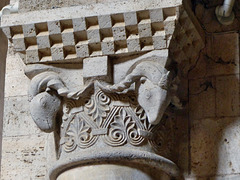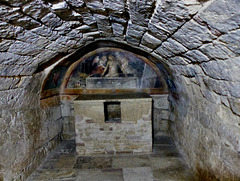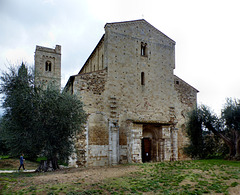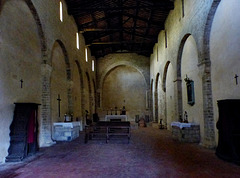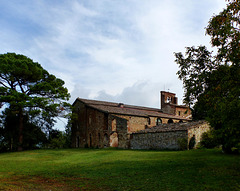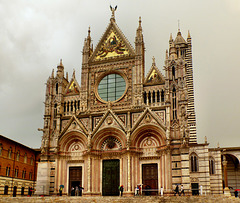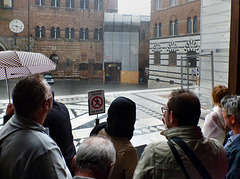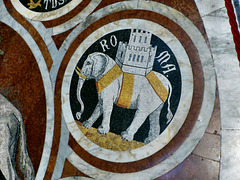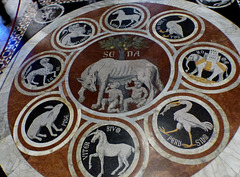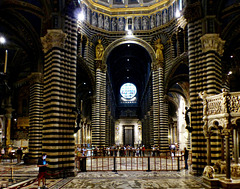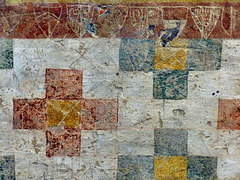
Italy
Photos taken in Italy (and Vatican State and San Marino).
Montalcino - Abbazia di Sant'Antimo
| |
|
|
|
It is proven, that the Abbazia di Sant'Antimo existed since Carolingian times. Legends (of course) know, that it was Charlemagne himself, who founded the abbey when he had left Rome, following the Via Francigana northward. The earliest document relating to the abbey is a land grant of Charlemagne´s son Louis the Pious from 813.
One year after the 1117 Verona earthquake, that destroyed so many buildings in Northern Italy, the erection of the church of today started. At that time the a powerful abbey was one of the largest landowners in the area.
The decline started in 1212, when, after a decade of hostility, an agreement stated that the abbey had to hand over a quarter of its territories to Siena, including Montalcino.
With the rise of the Dominican and the Franciscan Order, the Benedictines lost more influence. In 1462 Pope Pius II surpressed the abbey (just like Abbadia Ardenga, see previous uploads), annexed what ever was left - and handed it over to the Bishop of of Montalcino-Pienza, who was Pius' nephew.
The church is about 43 metres long, the nave is more than 20 metres high. There is an ambulatory with three chapels. The church is often compared to Saint-Étienne in Vignory (consecrated ~ 1050 /Burgundy /~ 1000 kms northwest). The influence of French architects and artists, maybe connected to Cluny, is undisputed.
There are many sculpted capitals along the nave. This one is noticeable.
Depicted is a "singe cordé", a man holding an ape or monkey on a rope. This is a very common icon in and around the Auvergne/France, but not in Italy.
Montalcino - Abbazia di Sant'Antimo
| |
|
It is proven, that the Abbazia di Sant'Antimo existed since Carolingian times. Legends (of course) know, that it was Charlemagne himself, who founded the abbey when he had left Rome, following the Via Francigana northward. The earliest document relating to the abbey is a land grant of Charlemagne´s son Louis the Pious from 813.
One year after the 1117 Verona earthquake, that destroyed so many buildings in Northern Italy, the erection of the church of today started. At that time the a powerful abbey was one of the largest landowners in the area.
The decline started in 1212, when, after a decade of hostility, an agreement stated that the abbey had to hand over a quarter of its territories to Siena, including Montalcino.
With the rise of the Dominican and the Franciscan Order, the Benedictines lost more influence. In 1462 Pope Pius II surpressed the abbey (just like Abbadia Ardenga, see previous uploads), annexed what ever was left - and handed it over to the Bishop of of Montalcino-Pienza, who was Pius' nephew.
The church is about 43 metres long, the nave is more than 20 metres high. There is an ambulatory with three chapels. The church is often compared to Saint-Étienne in Vignory (consecrated ~ 1050 /Burgundy /~ 1000 kms northwest). The influence of French architects and artists, maybe connected to Cluny, is undisputed.
There are many sculpted capitals along the nave.
Montalcino - Abbazia di Sant'Antimo
| |
|
|
It is proven, that the Abbazia di Sant'Antimo existed since Carolingian times. Legends (of course) know, that it was Charlemagne himself, who founded the abbey when he had left Rome, following the Via Francigana northward. The earliest document relating to the abbey is a land grant of Charlemagne´s son Louis the Pious from 813.
One year after the 1117 Verona earthquake, that destroyed so many buildings in Northern Italy, the erection of the church of today started. At that time the a powerful abbey was one of the largest landowners in the area.
The decline started in 1212, when, after a decade of hostility, an agreement stated that the abbey had to hand over a quarter of its territories to Siena, including Montalcino.
With the rise of the Dominican and the Franciscan Order, the Benedictines lost more influence. In 1462 Pope Pius II surpressed the abbey (just like Abbadia Ardenga, see previous uploads), annexed what ever was left - and handed it over to the Bishop of of Montalcino-Pienza, who was Pius' nephew.
The church is about 43 metres long, the nave is more than 20 metres high. There is an ambulatory with three chapels. The church is often compared to Saint-Étienne in Vignory (consecrated ~ 1050 /Burgundy /~ 1000 kms northwest). The influence of French architects and artists, maybe connected to Cluny, is undisputed.
There are many sculpted capitals along the nave. This one may be the result of a renovation. It seems so spotless compared to the carvings around.
Montalcino - Abbazia di Sant'Antimo
| |
|
|
It is proven, that the Abbazia di Sant'Antimo existed since Carolingian times. Legends (of course) know, that it was Charlemagne himself, who founded the abbey when he had left Rome, following the Via Francigana northward. The earliest document relating to the abbey is a land grant of Charlemagne´s son Louis the Pious from 813.
One year after the 1117 Verona earthquake, that destroyed so many buildings in Northern Italy, the erection of the church of today started. At that time the a powerful abbey was one of the largest landowners in the area.
The decline started in 1212, when, after a decade of hostility, an agreement stated that the abbey had to hand over a quarter of its territories to Siena, including Montalcino.
With the rise of the Dominican and the Franciscan Order, the Benedictines lost more influence. In 1462 Pope Pius II surpressed the abbey (just like Abbadia Ardenga, see previous uploads), annexed what ever was left - and handed it over to the Bishop of of Montalcino-Pienza, who was Pius' nephew.
The church is about 43 metres long, the nave is more than 20 metres high. There is an ambulatory with three chapels. The church is often compared to Saint-Étienne in Vignory (consecrated ~ 1050 /Burgundy /~ 1000 kms northwest). The influence of French architects and artists, maybe connected to Cluny, is undisputed.
The crypt below the choir is small, it was larger, when the church was erected.
Montalcino - Abbazia di Sant'Antimo
| |
|
|
|
It is proven, that the Abbazia di Sant'Antimo existed since Carolingian times. Legends (of course) know, that it was Charlemagne himself, who founded the abbey when he had left Rome, following the Via Francigana northward. The earliest document relating to the abbey is a land grant of Charlemagne´s son Louis the Pious from 813.
One year after the 1117 Verona earthquake, that destroyed so many buildings in Northern Italy, the erection of the church of today started. At that time the a powerful abbey was one of the largest landowners in the area.
The decline started in 1212, when, after a decade of hostility, an agreement stated that the abbey had to hand over a quarter of its territories to Siena, including Montalcino.
With the rise of the Dominican and the Franciscan Order, the Benedictines lost more influence. In 1462 Pope Pius II surpressed the abbey (just like Abbadia Ardenga, see previous uploads), annexed what ever was left - and handed it over to the Bishop of of Montalcino-Pienza, who was Pius' nephew.
The church is about 43 metres long, the nave is more than 20 metres high. There is an ambulatory (seen here) with three chapels. The church is often compared to Saint-Étienne in Vignory (consecrated ~ 1050 /Burgundy /~ 1000 kms northwest). The influence of French architects and artists, maybe connected to Cluny, is undisputed.
Montalcino - Abbazia di Sant'Antimo
| |
|
It is proven, that the Abbazia di Sant'Antimo existed since Carolingian times. Legends (of course) know, that it was Charlemagne himself, who founded the abbey when he had left Rome, following the Via Francigana northward. The earliest document relating to the abbey is a land grant of Charlemagne´s son Louis the Pious from 813.
One year after the 1117 Verona earthquake, that destroyed so many buildings in Northern Italy, the erection of the church of today started. At that time the a powerful abbey was one of the largest landowners in the area.
The decline started in 1212, when, after a decade of hostility, an agreement stated that the abbey had to hand over a quarter of its territories to Siena, including Montalcino.
With the rise of the Dominican and the Franciscan Order, the Benedictines lost more influence. In 1462 Pope Pius II surpressed the abbey (just like Abbadia Ardenga, see previous uploads), annexed what ever was left - and handed it over to the Bishop of of Montalcino-Pienza, who was Pius' nephew.
The church is about 43 metres long, the nave is more than 20 metres high. There is an ambulatory with three chapels at the eastern end. The church is often compared to Saint-Étienne in Vignory (consecrated ~ 1050 /Burgundy /~ 1000 kms northwest). The influence of French architects and artists, maybe connected to Cluny, is undisputed.
In 1992 Canons Regular of the Order of Premontre had revitalized monastic life here, I saw them on my first visit. Meanwhile Benedictines from the Abbey of Monte Oliveto Maggiore live here.
Montalcino - Abbazia di Sant'Antimo
| |
|
It is proven, that the Abbazia di Sant'Antimo existed since Carolingian times. Legends (of course) know, that it was Charlemagne himself, who founded the abbey when he had left Rome, following the Via Francigana northward. The earliest document relating to the abbey is a land grant of Charlemagne´s son Louis the Pious from 813.
One year after the 1117 Verona earthquake, that destroyed so many buildings in Northern Italy, the erection of the church of today started. At that time the a powerful abbey was one of the largest landowners in the area.
The decline started in 1212, when, after a decade of hostility, an agreement stated that the abbey had to hand over a quarter of its territories to Siena, including Montalcino.
With the rise of the Dominican and the Franciscan Order, the Benedictines lost more influence. In 1462 Pope Pius II surpressed the abbey (just like Abbadia Ardenga, see previous uploads), annexed what ever was left - and handed it over to the Bishop of of Montalcino-Pienza, who was Pius' nephew.
The decline had already started, when the facade was done around 1250. It was never completed, as the abbey obviously run out of funds. The work for a double portal were pretty advanced already, when the work came to an halt. The missing half of this now forms the portal of Santa Maria Assunta in San Quirico d’Orcia (15kms northeast).
Montalcino - Abbazia di Sant'Antimo
| |
|
|
|
It is proven, that the Abbazia di Sant'Antimo existed since Carolingian times. Legends (of course) know, that it was Charlemagne himself, who founded the abbey when he had left Rome, following the Via Francigana northward. The earliest document relating to the abbey is a land grant of Charlemagne´s son Louis the Pious from 813.
One year after the 1117 Verona earthquake, that destroyed so many buildings in Northern Italy, the erection of the church of today started. At that time the a powerful abbey was one of the largest landowners in the area.
The decline started in 1212, when, after a decade of hostility, an agreement stated that the abbey had to hand over a quarter of its territories to Siena, including Montalcino.
With the rise of the Dominican and the Franciscan Order, the Benedictines lost more influence. In 1462 Pope Pius II surpressed the abbey (just like Abbadia Ardenga, see previous uploads), annexed what ever was left - and handed it over to the Bishop of of Montalcino-Pienza, who was Pius' nephew.
Seen from here the church looks rather like a Romanesque Burgundian church. There is indeed a strong influence from France here.
Montalcino - Abbazia di Sant'Antimo
| |
|
|
Approaching Sant'Antimo. When I visited this area about a decade ago, Sant'Antimo was one of my favourite places. So I just had to see it again (and take some more photos).
It is proven, that the abbey existed since Carolingian times. Legends (of course) know, that it was Charlemagne himself, who founded the abbey when he had left Rome, following the Via Francigana northward. The earliest document relating to the abbey is a land grant of Charlemagne´s son Louis the Pious from 813.
Montalcino - Abbadia Ardenga
| |
|
|
The Abbadia Ardenga (aka Badia Ardenga) was founded in the 11th century. Soon after the erection of the abbey church, dedicated to Saint Andrew will have started. In 1464, after more than 3 centuries of prospering development, the abbey was suppressed, for unknown reasons, by Pope Pius II.
The place seemed to be "private", so I knocked at some doors. Nobody was "at home". But then I found the door of the church open!!
I had learned from a sign, that the church once had a nave, two aisles and three apses, and that the ancient crypt once run along the entire length of the church.
It is now smaller, but still impressive. There are traces of floral decorations under the vaults.
Montalcino - Abbadia Ardenga
| |
|
The Abbadia Ardenga (aka Badia Ardenga) was founded in the 11th century. Soon after the erection of the abbey church, dedicated to Saint Andrew will have started. In 1464, after more than 3 centuries of prospering development, the abbey was suppressed, for unknown reasons, by Pope Pius II.
The place seemed to be "private", so I knocked at some doors. Nobody was "at home". But then I found the door of the church open!!
I had learned from a sign, that the church once had a nave, two aisles and three apses, but only the central nave still existed.
If this is the nave, than the church must once have been have been a pretty wide basilica. In the right corner is a stair leading down to the crypt.
Montalcino - Abbadia Ardenga
| |
|
|
The Abbadia Ardenga (aka Badia Ardenga) was founded in the 11th century. Soon after the erection of the abbey church, dedicated to Saint Andrew will have started. In 1464, after more than 3 centuries of prospering development, the abbey was suppressed, for unknown reasons, by Pope Pius II.
I could seen the church and a few of the convents building from the dirt road, and learned from a sign, that the church once had a nave, two aisles and three apses, but only the central nave still existed.
I knocked at some doors, but nobody was "at home", when I approached the church.
Siena - Duomo di Siena
| |
|
|
|
The rain had ceased - a little bit...
The construction of the cathedral started in 1196, about 150 years later, the church may have been completed, but a massive addition of the cathedral was planned in 1339. It would have more than doubled the size of the structure and so it would have been larger than (old) Saint Peter in Rome. This cathedral was never completed.
The west facade was begun in 1285, Giovanni Pisano as the architect. He completed the lower level by 1297, but left Siena after a quarrel with the Opera del Duomo. The work continued until 1317, but then came to an halt. Inspired by the facade of Orvieto Cathedral the work started again in 1376.
The statues seen here, many of them by Giovanni Pisano, are replicas, the originals are displayed in the Museo dell'Opera.
Siena - Duomo di Siena
| |
|
The heavy rain continued outside so nobody could leave the Duomo. A large crowd of wet tourists waited in the porch...
Siena - Duomo di Siena
| |
|
The construction of the cathedral of today started in 1196, about 150 years later, the church may have been completed, but a massive addition of the cathedral was planned in 1339.
It would have more than doubled the size of the structure and so it would have been larger than (old) Saint Peter in Rome. This cathedral was never completed.
The interior of the Duomo is rather stunning, with black-and-white striped pillars and ornate decoration on every surface. The pavement of Cathedral features etched and inlaid marble panels created from 1372 to 1547.
This elephant symbolizes Rome (see the complete picture on the previous uplaod). Is this a "medieval elephant" . or one of the first "modern elephants"?
Hanno was an Indian elephant given to Pope Leo X by King Manuel I of Portugal. Hanno reached Rome in 1514 and became a favourite of the papal court and was featured in processions. Hanno was very popular - and died two years later from complications of a treatment for constipation with gold-enriched laxative.
The elephant seen here is very precise - maybe this is indeed Hanno.
Siena - Duomo di Siena
| |
|
The construction of the cathedral of today started in 1196, about 150 years later, the church may have been completed, but a massive addition of the cathedral was planned in 1339.
It would have more than doubled the size of the structure and so it would have been larger than (old) Saint Peter in Rome. This cathedral was never completed.
The interior of the Duomo is rather stunning, with black-and-white striped pillars and ornate decoration on every surface. The pavement of Cathedral features etched and inlaid marble panels created from 1372 to 1547.
Here in the center is a she-wolf suckling twins. The boys are Senius and Aschius, the legendary founders of Siena. They were sons of Remus and so had to flee from Rome, after uncle Romulus had killed their father. So the she-wolf stans for Siena - surrounded by eight allied cities. Rome is symbolized by an elephant.
Siena - Duomo di Siena
| |
|
|
The construction of the cathedral of today started in 1196, about 150 years later, the church may have been completed, but a massive addition of the cathedral was planned in 1339.
It would have more than doubled the size of the structure and so it would have been larger than (old) Saint Peter in Rome. This cathedral was never completed.
The interior of the Duomo is rather stunning, with black-and-white striped pillars and ornate decoration on every surface. There is much to see, including a number of important art masterpieces. Giovanni Pisano´pulpit can be partly seen to the right.
The heavy rain had continued outside and I was completely soaked meanwhile. It was cold and damp inside the cathedral - and so I had no eyes for the beauties.
Siena - Duomo di Siena
| |
|
|
A cathedral and a bishop's palace existed here already within the 9th century. The construction of the cathedral of today started in 1196, about 150 years later, the church may have been completed, but a massive addition of the cathedral was planned in 1339.
It would have more than doubled the size of the structure by means of an entirely new nave and two aisles ranged perpendicular to the existing nave. The planned cathedral would have been larger than (old) Saint Peter in Rome, it was never completed.
The construction was halted by the Black Death in 1348. Then errors in the static of the building got evident.
A kind of under-church, that was underneath the choir of the cathedral had to be filled up, to give stability... and got completely forgotten.
In 1999 this crypt was found and got excavated over the next years. Some some phantastic frescoes from around 1280 were discovered here.
When the crypt about 700 years was filled up with debris, to stabilize the church above, it was clear that it would be unseen and - gone "for ever". So the workers had no hesitation, to leave graffiti on the walls.
Jump to top
RSS feed- Latest items - Subscribe to the latest items added to this album
- ipernity © 2007-2024
- Help & Contact
|
Club news
|
About ipernity
|
History |
ipernity Club & Prices |
Guide of good conduct
Donate | Group guidelines | Privacy policy | Terms of use | Statutes | In memoria -
Facebook
Twitter



